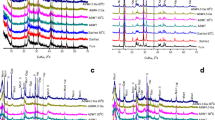Abstract
Experimental studies on the interactions between artificial seawater (ASW) and fresh rhyolite, perlite and weakly altered dacitic tuff containing a small amount of smectite suggest changing cation transfer during smectite-forming processes. Initially, dissolution of K from the rocks accompanies incorporation of Mg and Ca from ASW during both earlier (devitrification stage) and later smectite formation, whereas Ca incorporated with early smectite formation redissolves with progressive reaction. Barium mobility increases toward the later smectite-forming reactions. Therefore, the large amounts of barite, anhydrite and gypsum in Kuroko ore deposits are considered to have precipitated from hydrothermal solutions derived from the interaction with previously altered felsic rocks during late smectite formation, rather than by the reaction with fresh felsic rocks.




Similar content being viewed by others
References
Edmond JM, Measure C, McDuff RE, Chan LH, Collier R, Grant B, Gordon LI, Corliss JB (1979) Ridge crest hydrothermal activity and balance of major and minor elements in the ocean. The Galapagos data. Earth Planet Sci Lett 46:1–18
Farrell CL, Holland HD (1983) Strontium isotope geochemistry of the Kuroko deposits. Econ Geol Monograph 5:302–319
Farrell CW, Holland HD, Petersen U (1978) The isotopic composition of strontium in barite and anhydrite from Kuroko deposits. Mining Geol 28: 281–291
Gena K, Mizuta T, Ishiyama D, Urabe T (2001) Acid-sulphate type alteration and mineralization in Desmos Caldera, Manus Back-arc Basin, Papua New Guinea. Resource Geol 51:31–44
Hajash A, Chandler GW (1981) An experimental investigation of high-temperature interactions between rhyolite, andesite, basalt and peridotite. Contrib Min Petrol 78:240–254
Ishikawa Y, Sawaguchi T, Iwaya S, Horiuchi M (1976) Delineation of prospecting targets for Kuroko deposits based on modes of volcanism of underlying dacite and alteration haloes (in Japanese, with English Abstr). Mining Geol 26:105-117
Kajiwara Y (1971) Sulfur isotope study of Kuroko-ores of Shakanai No.1 deposits, Akita Prefecture, Japan. Geochem J 4:157–181
Kusakabe M, Chiba H (1979) Oxygen isotope geothermometry applicable to sulphate minerals from the Kuroko deposits. Mining Geol 29:257–264
Kusakabe M, Mayeda S, Nakamura E (1990) S, O and Sr isotope systematics of active vent materials from the Mariana basin spreading axis at 18 °N. Earth Planet Sci Lett 100:275–282
McDuff RE, Edmond JM (1982) On the fate of sulfate during hydrothermal circulation at mid-ocean ridges. Earth Planet Sci Lett 57:117–132
Michard A, Albarede F, Michard G, Minster JF, Charlou JL (1983) Rare-earth elements and uranium in high-temperature solutions from East Pacific Rise hydrothermal vent field (13 °N). Nature 303: 795–797
Mottl MJ, Holland HD (1978) Chemical exchange during hydrothermal alteration of basalt by seawater-I. Experimental results for major and minor components of seawater. Geochim Cosmochim Acta 42:1103–1115
Sakai H, Matsubaya O (1974) Isotopic geochemistry of the thermal waters of Japan and its bearing on the Kuroko ore deposits. Econ Geol 69: 974–991
Sato T (1973) A chlorite complex model for Kuroko mineralization. Geochem J 7:245–270
Seyfried W, Bischoff MJ (1981) Experimental seawater-basalt interaction at 300 °C, 500 bars, chemical exchange, secondary mineral formation and implications for the transport of heavy metals. Geochim Cosmochim Acta 45:135–147
Shikazono N (1983) Genesis of sulfate minerals in the Kuroko deposits (in Japanese, with English Abstr). Mining Geol Spec Issue 11:229–249
Shikazono N, Holland HD, Quirk RF (1983) Anhydrite in Kuroko deposits: mode of occurrence and depositional mechanisms. Econ Geol Monograph 5: 329–344
Shiraki R, Iiyama T (1990) Na-K ion exchange reaction between rhyolitic glass and (Na,K)Cl aqueous solution under hydrothermal conditions. Geochim Cosmochim Acta 54:2923–2931
Shiraki R, Sakai H, Endo M, Kishima N (1987) Experimental studies on rhyolite- and andesite-seawater interactions at 300 °C and 1000 bars. Geochem J 21:139–148
Sumi K, Moritani T (1973) Geology of the Yonaizawa district. Quadrangle Series, Scale 1:50,000 (in Japanese with English Abstr p4). Geol Surv Japan:46
Urabe T, Scott SD, Hattori K (1983) A comparison of footwall-rock alteration and geothermal systems beneath some Japanese and Canadian volcanogenic massive sulfide deposits. Econ Geol Monograph 5:345–364
Utada M, Ishikawa Y, Takahashi T, Hashiguchi H (1983) The distribution of alteration zones in the western area (Hanaoka-Matsumine-Shakanai mineralization area) of the Hokuroku District, northeast Japan (in Japanese, with English Abstr). Mining Geol (Special Issue) 11:125–138
Acknowledgements
The authors thank Prof. O. Matsubaya (Akita University) for use of the autoclaves in his laboratory, and Prof. D. Lentz (University of New Brunswick) Dr. R.A. Binns (CSIRO), and Prof. B. Lehmann (Technical University of Clausthal) for valuable advice on this manuscript. T. Ogata (Hokkaido University) and K. Watanabe (Akita University) and H. Kashiwagi (Keio University) are thanked for their support and assistance with sample analysis.
Author information
Authors and Affiliations
Corresponding author
Additional information
Editorial handling: D. Lentz
Rights and permissions
About this article
Cite this article
Ogawa, Y., Shikazono, N., Ishiyama, D. et al. An experimental study on felsic rock–artificial seawater interaction: implications for hydrothermal alteration and sulfate formation in the Kuroko mining area of Japan. Miner Deposita 39, 813–821 (2005). https://doi.org/10.1007/s00126-004-0454-8
Received:
Accepted:
Published:
Issue Date:
DOI: https://doi.org/10.1007/s00126-004-0454-8




